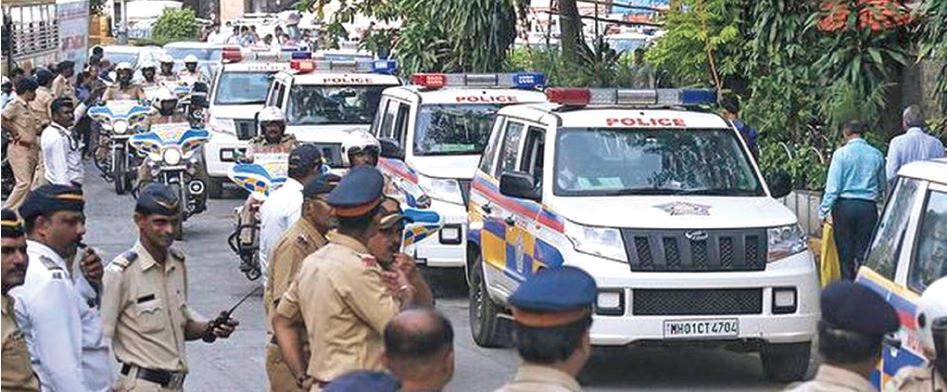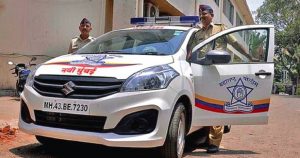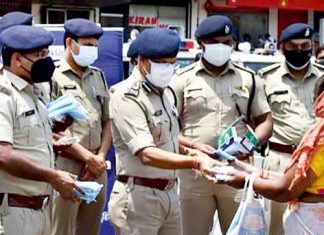 In a bid to add some firepower to its patrolling department, the Mumbai Police have acquired a set of 195 Mahindra TUV300s. The city police will soon be seen patrolling with the newly launched – Mahindra TUV300s instead of Mahindra Bolero, after the Chief Minister of Maharashtra, Devendra Fadnavis, gave the green signal. The other popular patrolling partners of Mumbai Police include vehicles like Bolero, Scorpio, Innova, Gypsy and Ertiga.
In a bid to add some firepower to its patrolling department, the Mumbai Police have acquired a set of 195 Mahindra TUV300s. The city police will soon be seen patrolling with the newly launched – Mahindra TUV300s instead of Mahindra Bolero, after the Chief Minister of Maharashtra, Devendra Fadnavis, gave the green signal. The other popular patrolling partners of Mumbai Police include vehicles like Bolero, Scorpio, Innova, Gypsy and Ertiga.
A total of 195 units of Mahindra TUV300 have been inducted in the Mumbai Police fleet as patrolling vehicles. They are ideally suited for this task. The SUVs are compact, can seat up to seven persons, and are capable of being driven through all kinds of congested road conditions which is a common sight in Mumbai.
The top of the line Mahindra TUV300 T4+ trim that have been inducted in the police force are less than four meters in length. They are therefore easy to manoeuvre in comparison to an Innova or Scorpio.
Appeal
 Some exterior modifications have been made to the vehicle in the form of yellow and blue chequered decals with the police insignia on either side. To be used as police patrolling cars will mean that the TUV300s are fitted with roof mounted LED lights with a siren and a public address system, along with a few other necessary gadgets. The look is completed with a blue and white finish.
Some exterior modifications have been made to the vehicle in the form of yellow and blue chequered decals with the police insignia on either side. To be used as police patrolling cars will mean that the TUV300s are fitted with roof mounted LED lights with a siren and a public address system, along with a few other necessary gadgets. The look is completed with a blue and white finish.
Vehicle Details
Mahindra TUV300 is powered with a 1.5 litre mHawk diesel engine offering 100 PS power at 3,750 rpm and 240 Nm torque at 1,600-2,800rpm mated to a 5 speed manual transmission. The TUV300 T4+ trim offers fuel efficiency of 11.4 kmpl in city limits and 15.5 kmpl on the highway. It will replace Mahindra Bolero that has been in use by the Mumbai Police for over a decade. While the Gypsy had been serving the Indian Army and police forces for long, it is becoming defunct and will soon go out of production. Maruti Suzuki is expected to offer an alternative to the Gypsy in India, and it could be in the form of the new Jimny that is set for a global showcase soon.
Ensuring Coordination Between Control Room, CCTV Network and Patrol Teams
The upgraded Mumbai Police Helpline Number 100 equipped with state-of-the-art improvements, went operational on June 28, 2018. The upgrades aim to reduce the response time and ensure that the police will take effective action on information or complaints from citizens to the control room.
 The ‘Dial 100’ initiative was developed over several months at a cost of Rs.29 crores. The control room is now equipped with an integrated system that ensures coordination between the control room personnel, the CCTV camera network in the city, and patrolling units of the Mumbai Police.
The ‘Dial 100’ initiative was developed over several months at a cost of Rs.29 crores. The control room is now equipped with an integrated system that ensures coordination between the control room personnel, the CCTV camera network in the city, and patrolling units of the Mumbai Police.
With the new system, the police can trace the location of a caller while he is speaking to the control room personnel, with assistance from telecom service providers. The location will be conveyed to police personnel manning the CCTV network, and the nearest camera will be used to verify the caller’s information.
Once verified, the information will be sent to the nearest patrolling vehicle which is equipped with portable terminals capable of receiving/sending text, audio and visual data. The vehicle will then be diverted to the location concerned for immediate response.
Ensuring Transparency
 While inaugurating the new system, CM Fadnavis said, “Mumbai is the first city in the country to have a system like this. The system records the time of the call and the time taken for responding, which can be accessed by senior officers at a later date for analysis; enabling them to take action in case of delayed or lax response.”
While inaugurating the new system, CM Fadnavis said, “Mumbai is the first city in the country to have a system like this. The system records the time of the call and the time taken for responding, which can be accessed by senior officers at a later date for analysis; enabling them to take action in case of delayed or lax response.”
The new system will also make it easier for the police to trace and take action against prank callers. The control room, which receives over 25,000 calls a day, is plagued with scores of prank calls.
The Chief Minister also launched the Mumbai Police Information System, allows police to share internal communication on a secure internal server, reducing use of paper; the Automated Biometric Information System, that stores biometric data of all the arrested accused in a digital format, and the SAMVAD App for interdepartmental communication.
by Mohit Naik













